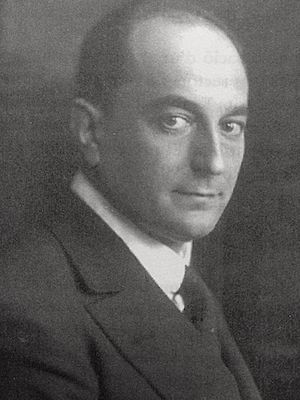Esteban Terradas i Illa facts for kids
Esteban Terradas i Illa (born September 15, 1883, in Barcelona; died May 9, 1950, in Madrid) was a brilliant Spanish mathematician, scientist, and engineer. He was also known as Esteve Terradas. He spent his life researching and teaching about mathematics and physical sciences. He worked in his home region of Catalonia, across Spain, and even in South America. Esteban Terradas was also an important advisor for Spanish industries. These included aeronautics (things about airplanes), electric power, telephone systems, and railways.
Contents
Becoming a Scientist and Teacher
Esteban Terradas was an amazing student. He entered university in 1898 when he was only 15 years old! By 1904, he had earned two doctorate degrees. One was in mathematics and the other in physics. He also had two degrees in engineering.
Early Career and Studies
He became a professor at the University of Barcelona. There, he taught advanced mathematical analysis and mathematical physics. He also taught about acoustics (sound), optics (light), electricity, magnetism, and classical mechanics (how things move). He even taught mechanics at universities in Zaragoza, Buenos Aires (Argentina), La Plata (Argentina), and Montevideo (Uruguay).
Terradas studied in different cities like Berlin, Barcelona, and Madrid. In 1909, he wrote an important paper called Emisión de radiaciones por cuerpos fijos o en movimiento. This means "Emission of radiation by fixed or moving bodies."
Sharing Knowledge and New Ideas
Esteban Terradas loved to teach and share knowledge. He wrote articles for science magazines. He also started a special physics-mathematics group. He invited some of the best scientists of his time to join this group.
In 1911, he helped create the Science Section of the Institut d'Estudis Catalans. This group helped promote advanced studies. He also wrote a book about radium. In 1919, he set up and directed the Institute of Electricity and Applied Mechanics.
Terradas was very interested in photography. This was a new technology in the early 1900s. He used photos to show his scientific work and also in his personal life.
Bringing Big Minds to Barcelona
He was fascinated by new ideas like quantum theory and relativity. He invited famous scientists to Barcelona to share their ideas. These included Jacques Hadamard (1921), Hermann Weyl (1921), Arnold Sommerfeld (1922), and Tullio Levi-Civita (1922).
One of his biggest achievements was inviting Albert Einstein to Barcelona in 1923. Einstein's visit was a huge success! Terradas helped organize it with the Catalan Government. After these visits, Terradas helped publish a series of science books. These books shared the lectures from these famous scientists, including his own work.
He also taught at several universities in South America. He was in Buenos Aires and Rio de la Plata (Uruguay) from 1936 to 1939. In 1932, he became the first professor to hold the chair in Differential Equations in Madrid.
Helping Spanish Industries Grow
Esteban Terradas was a key advisor for many important industries in Spain.
Working with Railways
In 1918, Terradas was chosen to lead a project for the Secondary Net of Catalan Railways. This project aimed to improve transport in Catalonia. However, it was never finished because of a dictatorship that started in 1923.
He also worked as a technical director for the Catalan government's railways. From 1923 to 1925, he directed and planned the building of the Transversal Metropolitan Railway of Barcelona. He also worked on other railway lines in Catalonia.
It is said that the President of Catalonia asked him to study the strength of a special type of brick arch. This arch is known as the "Catalan turn" or "Catalan vault."
Contributions to Other Industries
From 1940 onwards, he worked for the Spanish Instituto Nacional de Industria. He became one of the top advisors for Spain's industrial growth in the 1940s. He played a big role in planning and designing power plants built by Endesa. He also worked for the Compañía Telefónica Nacional de España, a telephone company. He was also a member of the Spanish National Research Council.
In 1942, he created the Spanish Instituto Nacional de Técnica Aeroespacial (National Institute of Aerospace Technology), known as INTA. After Terradas passed away, this institute was named after him. As the head of INTA, Terradas worked closely with the famous scientist Theodore von Karman in the late 1940s.
His Published Works
Esteban Terradas wrote many important books and articles. In 1910, he published "Discrete elements of matter and radiation." In 1941, he wrote "Corrientes marinas" (Ocean Currents). To become a member of the Royal Academy of the Spanish Language, he wrote "Neologismos, arcanismos in plàtica de ingenieros" (New words and old words in engineers' talk) in 1946.
He also wrote several articles for the Espasa Encyclopedia. These included topics like Celestial Mechanics (how planets move), the Moon, and relativity.
Images for kids
See also
 In Spanish: Esteban Terradas para niños
In Spanish: Esteban Terradas para niños



